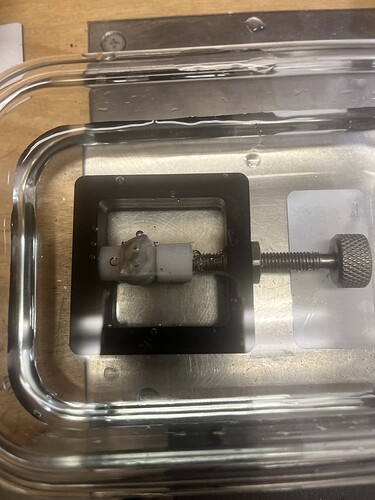Going to potentially drill some pearl holes from their original .5mm up to a .75 or 1mm width to reuse them in a new project, anyone have tips or input?
Hi, Chris -
Easy! Pearls are soft and there’s already a straight hole. I use steel twist drills in my flex shaft and hold the pearl in a ring clamp with leather padding to protect the pearl and my fingers.
I also wear a mask when drilling pearls. Breathing in shell from the mother-of-pearl bead at the center of most cultured pearls – South Sea pearls, Tahitian pearls, Japanese Akoya pearls, and some freshwater pearls – is unhealthy.
Mary
I frequently have to redrill pearls. I use an inexpensive pearl holder I got from Rio and I drill under water in a little Pyrex bowl. This likely removes the need to wear a mask…which is a good idea as pearl dust is toxic.
You can also buy special pearl drilling bits from Rio that have a little spade-like end that pushes the pearl dust out. The only issue I’ve had with them is that they dill a slightly larger hole than the stated drill bit size, and if you are planning on attaching the pearl to say a 20 gauge wire, your hole may be too large. So, drill smaller first and test the hole size as you proceed.
If you are planning to glue the pearl, there is a good post here on Ganoskin by Nancy Hamilton on types of glue for pearls.
Hope this is helpful.
What Deborah said! The water also keeps the drill bit cool - an asset. Just stating the obvious, but it’s important to separate electrical components from the water. Your flex shaft does that, but a Dremel-type hand tool DOES NOT.
Judy in Kansas, where a light snow fell last night and temps are staying low.
I asked one of the folks from Foredom folks once if they made or could make a waterproof flex shaft handpiece for drilling holes in rocks, pearls and shells. The person that I was talking to said it was a great idea, but as far as I know it never happened.
Remember that getting your flex shaft handpiece a little damp is probably fine, but you don’t want to get it soaking wet or to submerse it. Like Judy pointed out, you won’t get electrocuted, but I don’t think there are any flex shaft handpieces that are water tight. Something to remember.
I asked the Foredom person about the waterproof handpiece because Foredom makes a handy little plastic and stainless steel vise with grooves that’s designed to be submersed under water. I love drilling holes in rocks. It probably would work well for drilling pearls as well.
Cheers!
Jeff
I’m going to shout here. YOUR FLEXSHAFT SHOULD BE GROUNDED BEFORE YOU DO ANY DRILLING UNDER WATER. And never submergy the handpiece itself . . . only the accessories.
It is likely grounded as long as you have a three prong plug and circuit is properly wired. The important thing about working with electricity around water is that the outlet be protected by a GFI (ground fault interrupter). A GFI will open the circuit instantaneously if there is any current to ground rather than waiting for the regular circuit breaker to open the circuit…Rob
Thanks for that clarification Rob and Linda! Modern Foredom flex shafts all have three prong plugs, but some of the really old Foredom units just have two prong plugs. I don’t know about all of the other brands of flex shafts? Definitely best to check and if possible install a GFI receptacle. They’re not too hard to install.
Always best to be safe! Thanks again for mentioning this!
Jeff
I use the pearl drills with spade-like ends for starting a hole on an pearl. The steel twist drills can dance around on the nacre, marring the surface, whereas the sharp end of the spade end bites into the nacre and nicely tunnels in, leaving the surface of the pearl close to perfect.
Different ways to achieve the same end. As Mr. Spock would have said, “Fascinating.”
Thank you all for your help, everyone had valuable knowledge and tips for me to consider during this project. Much appreciated!
